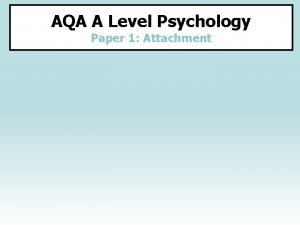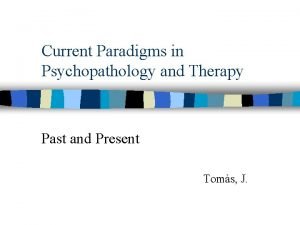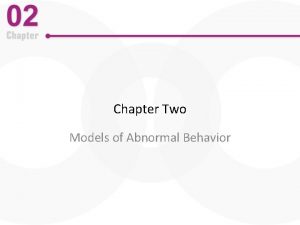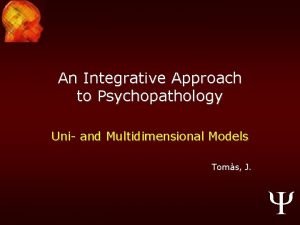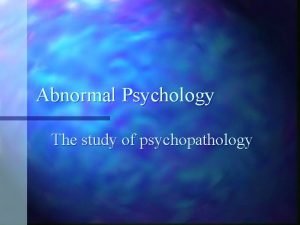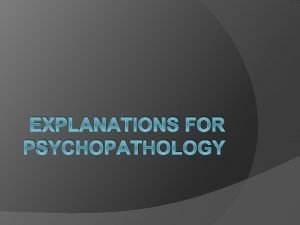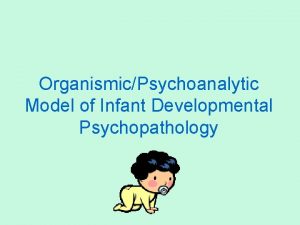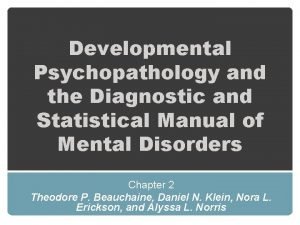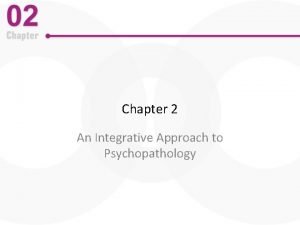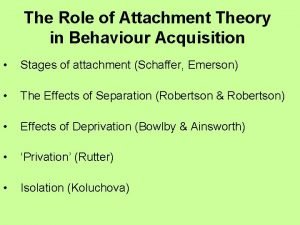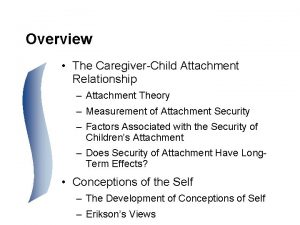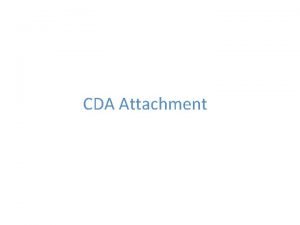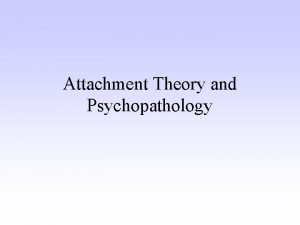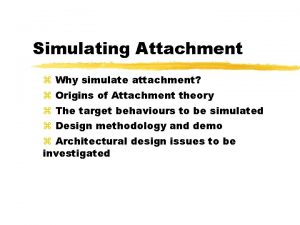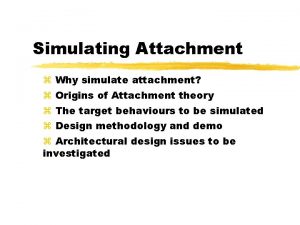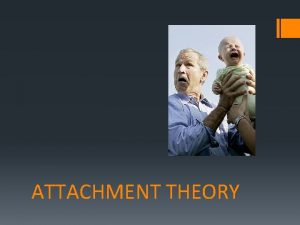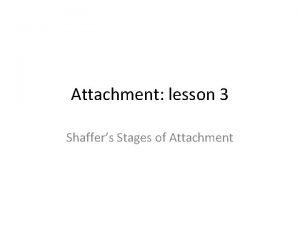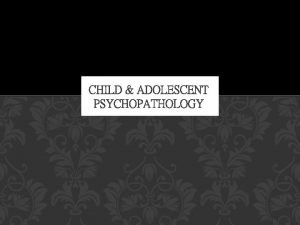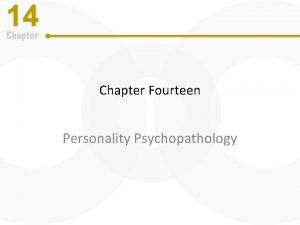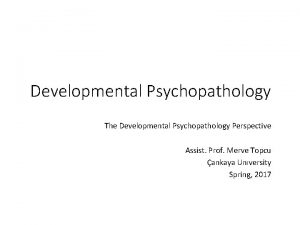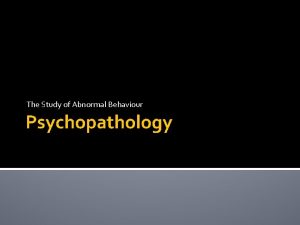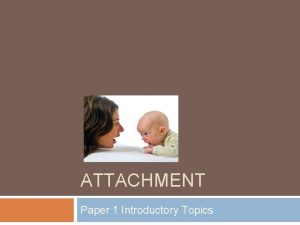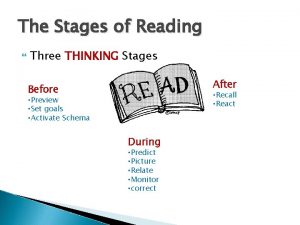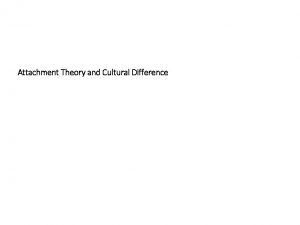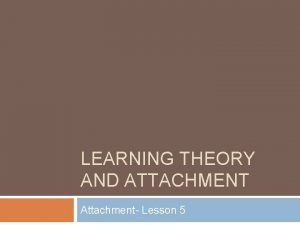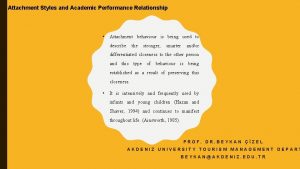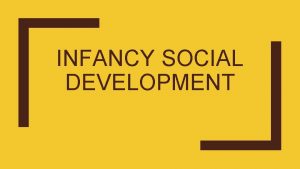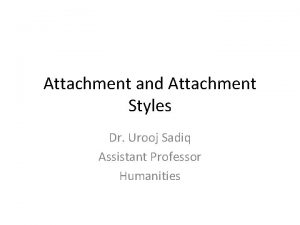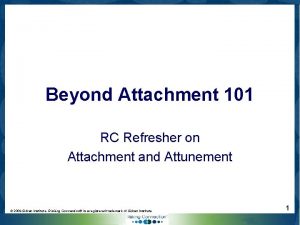Psychopathology and Attachment Name three stages in the



![Briefly evaluate learning theory as an explanation of attachment. [4 marks] • Possible evaluation Briefly evaluate learning theory as an explanation of attachment. [4 marks] • Possible evaluation](https://slidetodoc.com/presentation_image_h2/528e725735baf4500ba3c7117e170bc2/image-4.jpg)


![Discuss research into the influence of early attachment on adult relationships. [8 marks] • Discuss research into the influence of early attachment on adult relationships. [8 marks] •](https://slidetodoc.com/presentation_image_h2/528e725735baf4500ba3c7117e170bc2/image-7.jpg)








![Outline cognitive behaviour therapy as a treatment for depression. [4 marks] • General rationale Outline cognitive behaviour therapy as a treatment for depression. [4 marks] • General rationale](https://slidetodoc.com/presentation_image_h2/528e725735baf4500ba3c7117e170bc2/image-16.jpg)













- Slides: 29

Psychopathology and Attachment

Name three stages in the development of attachments identified by Schaffer. (3 marks) • Discriminate (1) Multiple (1) Pre-attachment (1)

Name the attachment type demonstrated by each of the children in the conversation above by writing the attachment type next to the name below. [3 marks] • Max = Securely attached/type B (1) • Jessica = Insecure/Anxious-resistant/ambivalent/type C • William = Insecure/Anxious-avoidant/type A (1)
![Briefly evaluate learning theory as an explanation of attachment 4 marks Possible evaluation Briefly evaluate learning theory as an explanation of attachment. [4 marks] • Possible evaluation](https://slidetodoc.com/presentation_image_h2/528e725735baf4500ba3c7117e170bc2/image-4.jpg)
Briefly evaluate learning theory as an explanation of attachment. [4 marks] • Possible evaluation points: • strengths: plausible and scientific as founded in established theory, ie likely that association between the provision of needs and the person providing those needs can lead to strong attachments; reinforcers clearly delineated • limitations: reductionist – the focus on basic processes (S-R links, reinforcement) too simplistic to explain complex attachment behaviours; environmentally deterministic such that early learning determines later attachment behaviours; theory founded in animal research and problems of inferring on the basis of animal studies • evidence used to support or refute the explanation: Schaffer and Emerson – more than half of infants were not attached to the person primarily involved in their physical care; Harlow – rhesus monkeys attach for contact comfort rather than food; sensitive responsiveness may be more influential in forming attachments (Ainsworth); infants are active seekers of stimulation, not passive responders (Schaffer) • comparison with alternative explanations, eg Bowlby’s theory.

Explain what is meant by ‘event sampling’. • 1 mark each for any two of the following points: • • observers/researchers decide on a specific event relevant to the investigation • relevant event is recorded every time it happens • in this investigation this may be every time a child in the playground is approached by/talks to/plays with another.

The investigation in question 09 is an example of a ‘naturalistic observation’. Briefly discuss how observational research might be improved by conducting observations in a controlled environment . [4 marks] • controlled environment affords the opportunity for control of extraneous variables • examples of extraneous variables that might be controlled and how/why they could affect • the outcome of a study if not controlled • exclusion of extraneous variables allows for greater inference about cause and effect • exclusion of extraneous variables means researcher can replicate the observation to check for reliability of the effect.
![Discuss research into the influence of early attachment on adult relationships 8 marks Discuss research into the influence of early attachment on adult relationships. [8 marks] •](https://slidetodoc.com/presentation_image_h2/528e725735baf4500ba3c7117e170bc2/image-7.jpg)
Discuss research into the influence of early attachment on adult relationships. [8 marks] • AO 1 Content: • Bowlby’s internal working model – early attachment provides blueprint/prototype for later (adult) attachment; formation of mental representation/schema of first attachment relationship; affects later relationships and own success as a parent • knowledge of studies that support or refute the relationship, eg Hazan and Schaffer; Quinton; Harlow; Freud and Dann; Koluchova.

A 03 • discussion of theory, eg Bowlby’s IWM and issue of determinism; negative implications of assumption that the relationship is cause and effect • discussion of underpinning evidence re measuring adult attachment type and/or methodological evaluation of studies that demonstrate a relationship and how this affects the conclusions to be drawn, eg difficulty of establishing cause and effect between early attachment history and adult relationships • counter-evidence, eg to suggest that children can recover from deprivation/privation and form effective adult relationships • ethical issues, eg associated with use of adult attachment interview • use of evidence to support or refute the relationship.

Psychopathology

Which two of the following are examples of Jahoda’s criteria for ‘ideal mental health’? Shade two boxes only. For each answer completely fill in the circle alongside the appropriate answer. [2 marks] • B and E.

Apart from ‘deviation from ideal mental health’, outline three definitions of abnormality. Refer to the article above in your answer. [6 marks] • Marks for this question: AO 1 = 3 and AO 2 = 3 AO 1 Outline: • statistical infrequency/deviation from statistical norms – abnormal behaviour is that which is rare/uncommon/anomalous • deviation from social norms – abnormal behaviour is that which goes against/contravenes unwritten rules/expectations (in a given society/culture) • failure to function adequately – abnormal behaviour is that which causes personal distress/anguish OR inability to cope with everyday life/maladaptiveness. • AO 2 Application to stem: • • statistical infrequency – ‘approximately 1 in 1000 people. . . ’ • deviation from social norms – ‘most of us are able to throw away the things we don`t need on • a daily basis. . . ’ • failure to function adequately – ‘difficulty parting with items and possessions. . . leads to • severe anxiety’ OR ‘affects living or work spaces’.

Suggest how the behavioural approach might be used to explain Kirsty’s phobia of balloons. [4 marks] • Kirsty’s phobia has developed through classical conditioning – she has formed an association between the neutral stimulus (balloon) and the response of fear the conditioned response is triggered every time she sees a balloon (or hears similar noises) • her phobia has generalised to situations where balloons might be present, such as parties and weddings, and to similar noises, ‘banging’ and ‘popping’ • her phobia is maintained through operant conditioning – the relief she feels when avoiding balloons becomes reinforcing.

Outline the type of relationship shown in Figure 1 above and suggest why it would not be appropriate for the researchers to conclude that better sleep improves mood. [2 marks] • Marks for this question: AO 3 = 2 Award 1 mark for outline of a positive correlation/as one variable increases, so does the other. and • 1 mark – It would not be appropriate because correlation only shows a relationship between the two variables, not cause.

Outline one way in which the researchers should have dealt with ethical issues in this study. [2 marks] 2 marks for a clear, coherent outline of an appropriate way of dealing with a relevant ethical issue. • 1 mark for a vague/muddled or incomplete outline of an appropriate way of dealing with a relevant ethical issue. • Relevant issues would include: • asking for consent: preferably written and on more than one occasion • offering the right to withdraw from the study • maintaining confidentiality • treating with respect.

Explain how this study could be modified by checking the sleep questionnaire for test-retest ability. [4 marks] • Marks for this question: AO 3 = 4 • The same participants would complete the sleep questionnaire on more than one occasion • each participants’ scores from the first occasion should be correlated with his/her results from the later occasion to be shown on a scattergraph to describe the correlation, with scores from the first test plotted on one axis and the scores from the second test plotted on the other axis • the strength of the correlation should then be assessed using either a Spearman’s rho test (or a Pearson’s r test) • the degree of reliability is then determined by comparing the correlation with the statistical table to determine the extent of correlation – there should be a (strong) positive correlation between the two sets of scores.
![Outline cognitive behaviour therapy as a treatment for depression 4 marks General rationale Outline cognitive behaviour therapy as a treatment for depression. [4 marks] • General rationale](https://slidetodoc.com/presentation_image_h2/528e725735baf4500ba3c7117e170bc2/image-16.jpg)
Outline cognitive behaviour therapy as a treatment for depression. [4 marks] • General rationale of therapy – to challenge negative thought/negative triad • identification of negative thoughts • Hypothesis testing; patient as ‘scientist’ • Data gathering through ‘homework’, eg diary keeping • Reinforcement of positive thoughts; cognitive restructuring • Credit other relevant aspects of cognitive behaviour therapy.

Is there a Criminal Personality type? Aim: to critically explore Eysenck’s theory of the criminal personality Take the Eysenck personality test http: //similarminds. com/eysenck. html

Use page 22 and 23 to answer the following questions • Name three personality traits proposed by Eysenck. • An individual who displays behaviours such as anxiety and nervousness would be characterised as which type of personality trait? • What is the biological basis for extraversion and neuroticism? • Explain how Eysenck's theory relates to the nature-nurture debate. • Explain the different reasons why individuals with different personality traits may commit a crime. • Describe one study that supports Eysenck's criminal personality theory and one study that challenges his theory.

Hans Eysenck (1947): The Eysenck Personality Inventory. I developed the Eysenck Personality Inventory, a form of psychological test which locates respondents along the E and N dimensions to determine their personality type. I believed that personality has a biological basis. Extraverts, for example, have an underactive nervous system which means that they constantly seek enjoyment through risk-taking behaviours. What are two issues with this theory?

(Digman, 1990) The five-factor model of personality is a hierarchical organisation of personality traits in terms of five basic dimensions: Extraversion, Agreeableness, Conscientiousness, Neuroticism, and Openness to Experience.

Additional evaluation points? • Link to the EPI and how we can test theory…but weakness come from the questionnaire method • Eysenck’s theory in the historical context as anti-liberal; relevance to eugenic ideal; • Basis for the model is in the EPI; reliability and validity issues re EPI; inability to infer cause and effect; • I & D: determinism and the implications of Eysenck’s emphasis on heritability and inevitability; reductionism and the need to consider wider influences, eg society;

u o y d i d How score?

KEYWORD: THE CRIMINAL PERSONALITY An individual who scores highly in measures of extraversion, neuroticism and psychoticism. They cannot be easily conditioned and are cold, unfeeling and likely to engage in offending behaviour. What are three problems with this definition? ?


Exam practice: 20 mins Discuss Eysenck’s theory of the criminal personality, referring to evidence within your answer (16 marks)

Charles Manson: can you spot the E, N, P qualities from this clip? https: //www. youtube. com/watch? v=k 9 QXY 80 Ox. S 0

Kohlberg’s theory

Heinz dilemma http: //www. simplypsychology. org/kohlberg. html Note: The names of some of the stages in the clip are slightly different to the ones in the pack – do not worry about this, your understanding of the differences between the stages is more important.

Task Read p 20 in the pack, then answer the question below: According to Kohlberg, which level of moral reasoning is more likely to lead to offending behaviour? Explain the reason for your answer and refer to evidence. (4 marks)
 Attachment psychology a level
Attachment psychology a level Current paradigms in psychopathology
Current paradigms in psychopathology Multipath model of abnormality
Multipath model of abnormality Multidimensional approach to psychopathology
Multidimensional approach to psychopathology What is psychopathology
What is psychopathology The supernatural tradition
The supernatural tradition Garrett model of speech production
Garrett model of speech production Psychopathology
Psychopathology Developmental psychopathology approach
Developmental psychopathology approach Multidimensional approach to psychopathology
Multidimensional approach to psychopathology Koluchova 1972
Koluchova 1972 Bowlby attachment theory
Bowlby attachment theory Name all the lines name all the segments name all the rays
Name all the lines name all the segments name all the rays Hình ảnh bộ gõ cơ thể búng tay
Hình ảnh bộ gõ cơ thể búng tay Frameset trong html5
Frameset trong html5 Bổ thể
Bổ thể Tỉ lệ cơ thể trẻ em
Tỉ lệ cơ thể trẻ em Voi kéo gỗ như thế nào
Voi kéo gỗ như thế nào Chụp phim tư thế worms-breton
Chụp phim tư thế worms-breton Hát lên người ơi alleluia
Hát lên người ơi alleluia Môn thể thao bắt đầu bằng từ chạy
Môn thể thao bắt đầu bằng từ chạy Thế nào là hệ số cao nhất
Thế nào là hệ số cao nhất Các châu lục và đại dương trên thế giới
Các châu lục và đại dương trên thế giới Công thức tính độ biến thiên đông lượng
Công thức tính độ biến thiên đông lượng Trời xanh đây là của chúng ta thể thơ
Trời xanh đây là của chúng ta thể thơ Cách giải mật thư tọa độ
Cách giải mật thư tọa độ Phép trừ bù
Phép trừ bù độ dài liên kết
độ dài liên kết Các châu lục và đại dương trên thế giới
Các châu lục và đại dương trên thế giới Thơ thất ngôn tứ tuyệt đường luật
Thơ thất ngôn tứ tuyệt đường luật
